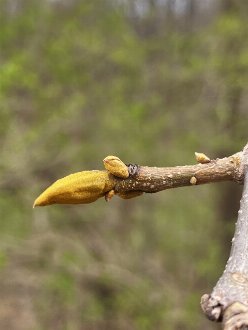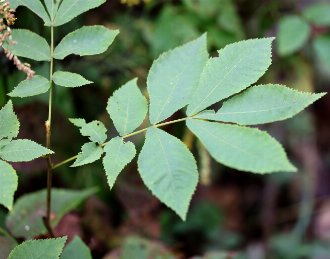Bitternut Hickory (Carya cordiformis (Wangenh.) K. Koch)
Also known as swamp hickory, pignut hickory.
↑Summary
A hickory of moist sites, characterized by its yellow buds, short lifespan, and unpalatable nuts.
↑Range - Expand
| Legend | Color |
| Native | |
| Native or Not Present |
This tentative map is based on our own research. It may have limited data on Canada and/or Mexico, and there is some subjectivity in our assignment of plants as introduced vs. expanded. Read more in this blog post.
Although this plant occurs somewhere in each of these regions, it may only occur in a small part of some or all of them.
↑Description & Identification
Bitternut is usually relatively easily distinguished from other hickories by its distinctive yellow buds, and tendency to have more leaflets per leaf.
↑Habitat
Found in in valleys along streams, and in swamps. In the south of its range, it is strictly restricted to moist bottomlands, but in the north of its range, although it is most common on moist sites, it also extends onto drier upland sites.
The soil types preferred by this species vary throughout its range. Throughout much of its range it is found mostly on ultisols, highly leached soils that tend to be acidic and low in mineral nutrients. Soil textures range from fine loams through coarse sands and gravels, and this species is usually absent from finest-textured soils, including poorly-drained clays, although it can sometimes be found in sloped terrain where a fragipan of poorly-drained clay underlies coarser-texture soil, as long as the terrain allows drainage.
In the western limits of this species, as rainfall decreases, this species is mostly limited to mollisols, soils rich in organic matter that typically form under prairies and other grasslands. In the northernmost portions of its range, it is found mainly on alfisols, soils richer in mineral nutrients.
It is mostly found in mid-to-late stages of forest succession, and is often found as a minor component of many other forest types, growing locally on suitable sites.
This species is intolerant of fire and is usually only found on sites where fire is uncommon to absent.
This species is the most abundant and uniformly distributed hickory in North America; within its range it tends to be consistently found within most suitable habitat.
↑Life Cycle
Bitternut is the shortest-lived of the hickory species in North America, typically living only to 200 years.
After sprouting in the spring, seedlings quickly establish a deep taproot, which can grow 1-3 feet in its first year. Initially, numerous small lateral roots develop from the taproot, but most of these die in the first fall. In subsequent years, the root system grows much wider than deep. The root system typically achieves its maximum depth by about five years, by which point the roots spread about twice as wide as the branches, a ratio that tends to be maintained over the lifetime of the tree.
The tree then invests mostly in height growth, to eventually grow about four times as tall as its root system is deep.
The structure of the root system remains consistent, with a single taproot and numerous small lateral roots proceeding horizontally from the taproot, none of which are dominant. There are usually 4-8 distinct cycles of root growth in each growing season, with the first starting shortly before shoot growth begins.
Trees tend to self-prune as they age, perhaps due to shade intolerance leading to the death of lower branches.
Seed production tends to be sparse until trees reach about 30 years of age, peaking between 50 and 125 years and mostly ceasing by about 175 years. Good seed crops occur at 3-5 year intervals, with light crops produced other years. Most seeds are viable, and germinate 3-6 months after seedfall, in the following spring. Seeds rarely remain viable more than a year, and this species does not persist long-term in the seed bank.
Unlike most nut trees, seed is distributed mostly by gravity and less by animals. Floodwaters may also play some role in dispersal. Seeds germinate underground; foliage may emerge earlier than other hickories, and is more resistant to frost.
Trees resprout readily and prolifically if top-killed; sprouts are able to arise from stumps, root crown, and roots alike. Younger trees are more likely to resprout from the root crown, whereas more mature trees are more likely to sprout from roots. Stump sprouts are less common but can occur in trees of any age.
Mature trees can be killed by fire, either directly or if injury caused by fire allows rot or disease to get established. Causes of mortality are not always clear, with trees seeming to suffer gradual decline with age, getting attacked by multiple insects and pathogens as they become stressed. In Wisconin, two of the proposed common causes of mortality for this species include the fungus Ceratocystis smalleyi and the bark beetle Scolytus quadrispinosus. Trees seem to be most vulnerable when density of this species is high, suggesting that this species is held in equilibrium.
↑Faunal Associations
Reflecting its name, the nuts are considered unpalatable to most animals, and are generally ignored by larger animals, although they are occasionally eaten in years where other more desireable nuts are scarce.
Rabbits, beavers, and small rodents sometimes feed on the bark.
↑Uses
The wood is considered highly desireable, and is usually lumped in with a grouping called "pecan hickories". Its wood is valued for its strength and shock resistance, but it is difficult to work with and als susceptible to decay and insect damage. It is typically used for tool handles, ladder rungs, wheel spokes, dowels, furniture, flooring, and other applications where strength is important.
The wood also has a high heat content and makes excellent firewood, and the aroma from the smoke is among the most desireable for smoking meats. It is also used to make charcoal.
This species is occasionally planted as a landscaping tree, but its use is limited by the fact that it quickly establishes a deep taproot, which does not fit well with the container shapes and planting practices most widely used in the nursery and landsacping industries. However, provided the taproot is kept intact, it is easier to transplant than other hickories. Although it is low-maintenance on moist, well-drained sites, it is not tolerant of drought, nor is it as tolerant of flooding or poor drainage as most species that require as much moisture as it does.
↑Related Plants
This species is probably closest-related to the pecan (Carya illinoinensis). There are numerous other Carya species in North America, but it is not particularly closely related to any of the others. However, it is closer related to these than any of the non-native Carya species found in East Asia.
Beyond its genus, among plants occurring in North America, this species is most closely related to walnuts (Juglans sp.), which include both native and introduced species, and to the introduced Chinese wingnut (Pterocarya stenoptera).
↑Links & External Resources
• Bitternut Hickory | The Wood Database (About This Site)
• Bitternut Hickory | Fire Effects Information System (FEIS) (About This Site)
• Carya cordiformis (Bitternut Hickory) | Illinois Wildflowers (About This Site)
• Carya cordiformis (Bitternut Hickory) | USDA PLANTS Database (About This Site)
• Carya cordiformis | Go Botany (About This Site)
• Carya cordiformis (Bitternut Hickory) | Missouri Botanical Garden Plant Finder (About This Site)
• Bitternut Hickory | Virginia Tech Dendrology Factsheets (About This Site)
• Bitternut Hickory | Silvics of North America (About This Site)
• Carya cordiformis | Biota of North America Project (BONAP) (About This Site)
• Carya cordiformis | NatureServe Explorer (About This Site)
• Carya cordiformis | Flora of North America (About This Site)
• Bitternut Hickory | Maryland Biodiversity Project (About This Site)
• Carya cordiformis (Wangenh.) K. Koch (Bitternut Hickory) | Digital Atlas of the Virginia Flora (About This Site)





